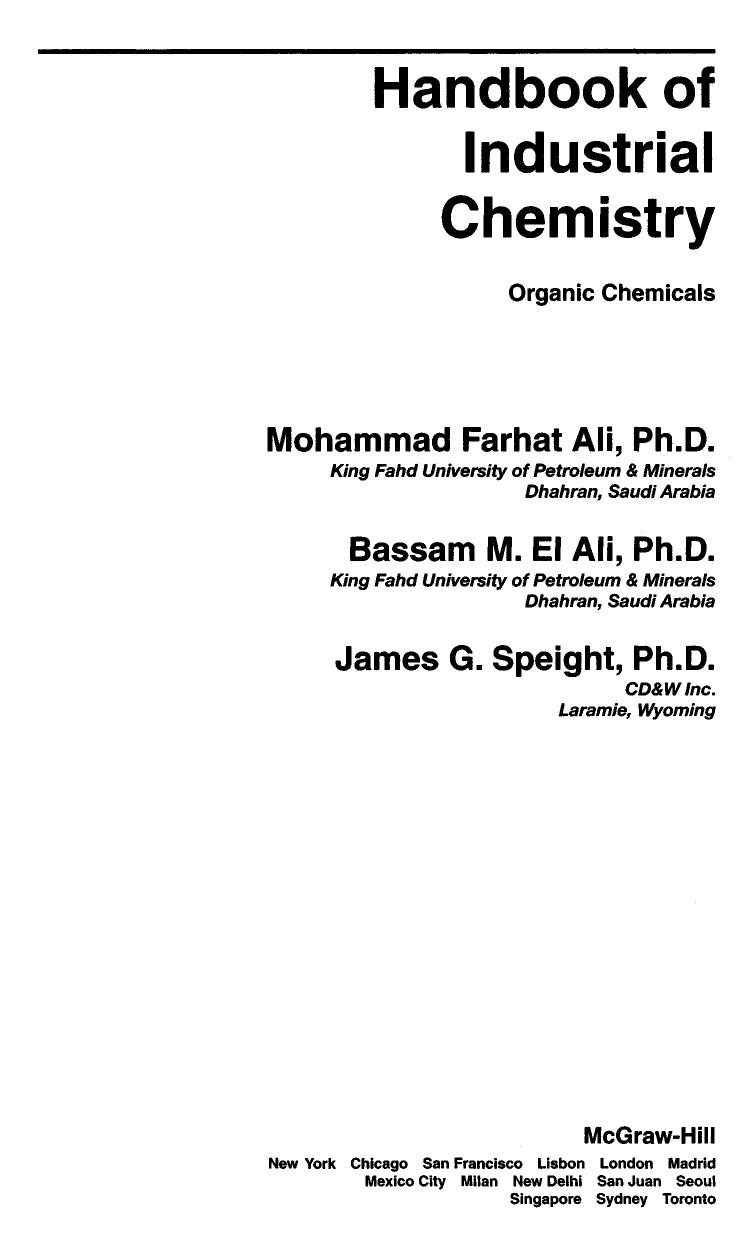书籍简介
- Introduction: an Overview of the Chemical Process Industry and Primary Raw Materials
- Safety Considerations in Process Industries
- Industrial Pollution Prevention
- Edible Oils, Fats, and Waxes
- Soaps and Detergents
- Sugar
- Paints, Pigments, and Industrial Coatings
- Dyes: Chemistry and Applications
- Industrial Fermentation
- The Pharmaceutical Industry
- Agrochemicals
- Chemical Explosives and Propellants
- Petroleum and Petrochemicals
- Synthetic Polymers
本书pdf是文字识别版,影印质量还行,书签良好。
Introduction: an Overview of the Chemical Process Industry and Primary Raw Materials
1.1 The Chemical Process Industry
1.2 Development of the Chemical Industry
1.3 Characteristics of the Chemical Industry
1.4 Raw Materials, Manufacturing, and Engineering
1.5 Environmental Aspects
Safety Considerations in Process Industries
2.1 Introduction
2.2 OSHA (Occupational Safety and Health Administration) and PSM (Process Safety Management)
2.3 Incident Statistics and Financial Aspects
2.4 Safety Decision Hierarchy
2.5 Hazard Analysis and Risk Assessment (HARA)
2.6 Types of Hazards in Industries
2.7 Risk Management Plan
Industrial Pollution Prevention
3.1 Definition of Industrial Waste
3.2 Types of Industrial Wastes
3.3 Public Concern over Pollution
3.4 Legislation to Waste Management
3.5 Industrial Pollution Prevention
3.6 Assessment of Industrial Pollution Prevention
3.7 Waste Management
3.8 Recycling
3.9 Waste Treatment
3.10 Waste Disposal by Incineration
3.11 Ultimate Disposal
Edible Oils, Fats, and Waxes
4.1 Introduction
4.2 Fatty Acids
4.3 Glycerides
4.4 Physical Properties of Triglycerides
4.5 Chemical Properties of Triglycerides
4.6 Sources of Edible Oils and Main Fats
4.7 Oils and Fats: Processing and Refining
4.8 Fats and Oils Stability and Antioxidants
4.9 Methods of Analysis and Testing of Fats and Oils
Soaps and Detergents
5.1 Soap
5.2 Detergent
5.3 Environmental Aspects
5.4 Economic Aspects
Sugar
6.1 Introduction
6.2 The Chemistry of Saccharides
6.3 Properties of Sucrose
6.4 Historical Survey and World Production
6.5 Cane Sugar
6.6 Beet Sugar
6.7 Other Sugars
6.8 By-Products of the Sugar Industry
6.9 Other Sweeteners
6.10 Sugar Analysis
Paints, Pigments, and Industrial Coatings
7.1 Introduction
7.2 Constituents of Paints
7.3 Paint Formulation
7.4 Paint Manufacture
7.5 Paint Application and Causes for Paint Failure
7.6 Testing and Quality Control
7.7 Environmental Impacts and Risks
Dyes: Chemistry and Applications
8.1 Introduction
8.2 Colorants
8.3 Classification of Dyes
8.4 Textile Fibers
8.5 The Application of Dyes
8.6 Intermediates
8.7 Manufacture of Dyes
8.8 Environmental and Health Aspects
Industrial Fermentation
9.1 Introduction and History
9.2 Biochemical and Processing Aspects
9.3 Food and Feed Treatment by Fermentation
9.4 Industrial Chemicals by Fermentation
9.5 Pharmaceutical Products by Fermentation
9.6 Environmental Biotechnology
9.7 Social and Economic Aspects
The Pharmaceutical Industry
10.1 Introduction
10.2 Use and Economic Aspects
10.3 Discovery and Development of Drugs
10.4 Classification and the Chemistry of Pharmaceutical Products
10.5 Industrial Processes in Pharmaceutical Industry
10.6 Manufacturing of Pharmaceutical Products
10.7 Quality Control
Agrochemicals
11.1 Introduction and History
11.2 Chemical Pest Control
11.3 Formulated Products
11.4 Biological Pest Control
11.5 Testing Requirements for New Pesticides
11.6 Social and Economic Aspects
Chemical Explosives and Propellants
12.1 Chemical Explosives
12.2 Propellants
12.3 Pyrotechnics
12.4 Manufacturing of Explosives
12.5 Thermochemistry of Explosives
12.6 Safety and Environmental Considerations
12.7 Classification, Transportation, and Storage of Explosives
Petroleum and Petrochemicals
13.1 Introduction
13.2 Desalting and Dewatering
13.3 Evaluation
13.4 Distillation
13.5 Cracking, Coking, Hydrocracking, and Reforming
13.6 Treating Processes
13.7 Petroleum Products
13.8 Fuel Gas (Refinery Gas) and Liquefied Petroleum Gas
13.9 Gasoline
13.10 Solvents
13.11 Kerosene
13.12 Fuel Oil
13.13 Lubricating Oil
13.14 Petroleum Wax
13.15 Asphalt
13.16 Coke
13.17 Petrochemicals
Synthetic Polymers
14.1 Basic Concepts and Definitions
14.2 Classification of Polymers
14.3 Polymers Industry
14.4 Polymer Structure
14.5 Polymer Structure-Property Relationships
14.6 Rheology
14.7 Molecular Weight of Polymers
14.8 The Synthesis of High Polymers
14.9 Polymerization Techniques
14.10 Copolymerization
14.11 Modification of Synthetic Polymers
14.12 Degradation, Stability, and Environmental Issues
14.13 Polymer Additives

Comments !